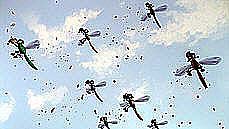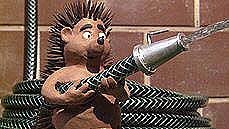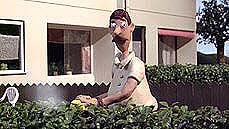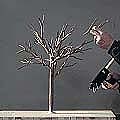Tyron Montgomery leads us through the production process of Our Garden, a stop motion theatrical piece he recently completed utilizing digital technology. Includes a Quicktime movie clip.

Last spring, the German Ministry of the Environment asked me to do an animated short film for them as an opening film for their 1998 open air cinema tour through Germany. I wrote a couple of scripts and they chose, as I had feared, the most technically complicated one. It was the story of an army of animals invading a sterile bourgeois garden and turning it into a beautiful biotope. So there I stood, with a budget of only US $30,000, looking at a ten-week schedule to complete a three-minute stop motion film for the cinema screen featuring approximately twenty characters and a bunch of sets.
It would have been impossible to "accomplish this mission" using only traditional techniques and doing everything as puppet animation. The main problem was caused by a swarm of dragon flies dropping thousands of seeds onto a lawn. I decided to do these elements and some others as computer animation. That, however, lead to the next problem: the budget simply didn't allow film scanning and film printing. So how was I to get the images in to the computer and back onto 35mm film?

Creating A Digital Set Up Then the idea was born to shoot the entire film on a digital still camera in a high resolution, therefore by-passing the film scanning process. I phoned all the animation directors, cameramen, and companies I knew, to see whether anyone had ever done this before and might be able to give me some advice. However, the answer was negative everywhere. Digital image recording was widely used in 2D animation, and some had used it for recording stop-motion on digital video, but nobody seemed to have gone any further. I had to start from scratch.
After going through many catalogues and web sites, I chose the Minolta RD 175 camera. It was not only the cheapest professional camera on the market but it also had the best technical features for my purpose. The camera's resolution of 1528 x 1146 pixels was higher than the resolution of other cameras in this price category and the images could still be viewed on a 1600 x 1200 monitor without scrolling.

The next step was buying an appropriate computer. I put together a Pentium 233 with 128 MB of RAM, 20 GB of SCSI-UW hard drives, with a Micro DC 30 video card, a Matrox Millennium 2 graphics accelerator, and the newest version of the Triple DAT sound card, which I had already worked with on Quest. It took me quite a while to find a monitor for a reasonable price that was able to display 1600 x 1200 pixels with good quality. I ended up with a 19" no-name product, which had a very good Hitachi tube that actually produced an even higher resolution than most 21" monitors. The cost of this recording system was not included in the budget of the film, so I wanted to keep it as low as possible. The only software I bought was Adobe Premiere for video editing. For everything else I used the software that came along with the cards, which was basically Adobe Photoshop Light (for scaling and color saturation), Micrografx Picture Publisher (for the post-production), and the Triple DAT sound editing software. For only $10,000 including the camera, I had put together a system on which I could now do the entire film recording, post-production, video editing and sound mix.

One problem still remained -- getting the images onto 35mm film. I decided to take the risk and go for the most primitive method of which one can think. The images were simply photographed right from the monitor screen, frame by frame with an animation camera. This was why the monitor had to be capable of displaying the images entirely and with good quality. Of course it was not that easy. Many tests were done to find out how gamma, color saturation, and monitor contrast had to be adjusted. Most people thought I was crazy and predicted it would never work. However when I showed the results around, everybody, including myself, was surprised with the quality of the final film images.
Getting It Done
While I was still in Paris (where I now live) doing designs, storyboards, schedules and all of that, four model making teams began working on the puppets, sets, and props in Germany. Most of the people were students, some of whom had never worked on a film before. The budget simply didn't allow everything to be made by professionals

The film was shot at the University of Kassel where I had studied and done Quest. I still had all of my lighting equipmentthere and the University was very kind to give me a studio and production office for free. I picked up the puppets and props that had been made in Frankfurt and Solingen, and went to Kassel. While two teams there were still working on houses and puppets, I started making additional sets and painting backdrops with a fifth team in one of the University's workshops.
The model makers in Frankfurt had sent the dragon fly puppet to Peter Lemken, a student in the animation class at Kassel, who also does computer animation. Peter modeled a digital counterpart in Imagine on an Amiga computer. We took some pictures of the dragon fly puppet with the RD 175 using the same light and digital filters I would later use in the production. With these images as a guideline, Peter then did the final surface textures and rough lighting set-ups. Peter didn't only animate the flying dragon flies, but also butterflies, water, and little mist clouds, all of which were then combined with the model shots. His three Amigas were kept busy, day and night, for four weeks.

The actual shooting was hell and brought me close to having a heart attack. There wasn't any money for any professional assistance; only for an apprentice, who took care of repairing the clay puppets in between shots and other things. Almost fifty shots had to be done in three weeks. Therefore, I had to setup, light, and animate two or three shots per day. The schedule didn't include any time for post-production or editing. All of that had to be done in the evening after the shooting. I imported the images from the camera's hard disk, added some filters and, if necessary, post-production elements or Peter's computer animation, and stored them on the computer's hard drive. They were then scaled down to TV resolution and converted into video files, so that I could finally see what I had animated that day. There wasn't any time to use a line tester. The video was later used as a guideline for the sound edit, while the film was still in the lab. The nights I spent either with Peter working on the computer animation, doing the office work (there was no producer but me), or taking care of the other limitless details. Three hours of sleep on a couch in the office, two packets of cigarettes per day, fast food, gallons of coffee and Red Bull....how wonderful the world of animation can be.

Post-Production and Beyond
There was no time for recovery though, because I had fallen a little behind my schedule after the shooting. Three days of manual film recording in a dark room followed, photographing the monitor images, as well as a few thousand miles on the road, traveling to the lab quite a few times, to my office in Paris for the sound edit, and the sound studio for the optical sound master. Only a few hours before the premiere of the open air tour, I finally arrived with the film prints in Aachen, where the first screening of the Ministry's program took place. They were happy with the results and I fell asleep! I think I have never worked so hard and with so much pressure on me as for this project (this article is really only half the story). However, it was absolutely worth it. Given a higher budget and more time, I probably would never have experimented with the digital technology that enabled me to produce the film in less time, with a lower budget, and of better quality than I could have done on film. Today, film still provides us with the best possible image quality, but sooner or later it will disappear. Digital film production has plenty of advantages and the special procedures described above give even low budget productions the opportunity to work with high-class effects and post-production. I will definitely work like this again in the future.
Tyron Montgomery is an independent filmmaker whose film, Quest, won the 1996 Academy Award for Best Animated Short Film







